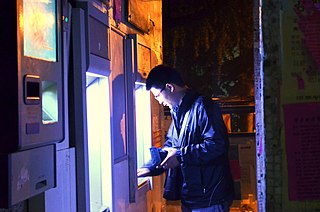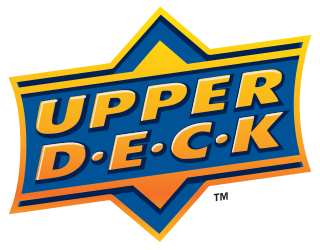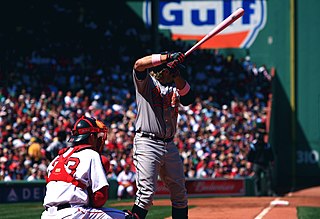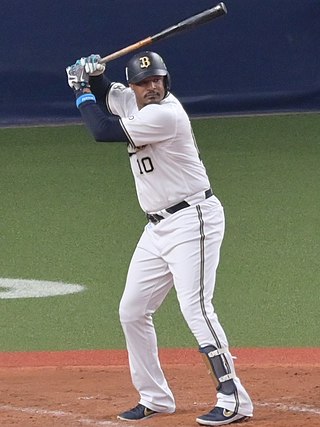
Authentication is the act of proving an assertion, such as the identity of a computer system user. In contrast with identification, the act of indicating a person or thing's identity, authentication is the process of verifying that identity. It might involve validating personal identity documents, verifying the authenticity of a website with a digital certificate, determining the age of an artifact by carbon dating, or ensuring that a product or document is not counterfeit.
A trading card is a small card, usually made out of paperboard or thick paper, which usually contains an image of a certain person, place or thing and a short description of the picture, along with other text. When traded separately, they are known as singles. There is a wide variation of different types of cards.

Anthony Keith Gwynn Sr., nicknamed "Mr. Padre", was an American professional baseball right fielder, who played 20 seasons (1982–2001) in Major League Baseball (MLB) for the San Diego Padres. Gwynn, who hit left-handed, won eight batting titles in his career, which is tied for the most in National League (NL) history. He was a 15-time All-Star and won seven Silver Slugger Awards and five Gold Glove Awards. Gwynn stayed with the Padres his entire career, and played in the only two World Series appearances in San Diego franchise history. Having hit over .300 for 19 straight seasons, Gwynn retired with a .338 career batting average, the highest mark since Ted Williams retired in 1960. He was inducted into the Baseball Hall of Fame in 2007 in his first year of eligibility.

The Upper Deck Company, LLC is a private company primarily known for producing trading cards. It was founded in 1988. Its headquarters are in Carlsbad, California, United States.

Ricardo Bones is a Puerto Rican former professional baseball pitcher and bullpen coach for the Washington Nationals of Major League Baseball (MLB). He played from 1991 to 2001 for three National League teams – the San Diego Padres, Cincinnati Reds, and Florida Marlins – and four American League teams – the Milwaukee Brewers, Kansas City Royals, New York Yankees, and Baltimore Orioles.

The St. Louis Cardinals Hall of Fame and Museum is a team hall of fame located in downtown St. Louis, Missouri, representing the history, players and personnel of the professional baseball franchise St. Louis Cardinals of Major League Baseball (MLB). It is housed within Ballpark Village, a mixed-use development and adjunct of Busch Stadium, the home stadium of the Cardinals. To date, 55 members have been enshrined within the Cardinals Hall of Fame.

In baseball, pink bats are limited-supply baseball bats manufactured by Louisville Slugger for use by select Major League Baseball players on Mother's Day, first introduced in 2006 in association with the Susan G. Komen for the Cure organization. Each year on Mother's Day, Major League Baseball authorizes the use of the specially dyed bats — temporarily suspending the regulation that restricts players to using black, brown, red, or white bats — as part of a weeklong program to benefit the Susan G. Komen for the Cure organization.

Adam LaMarque Jones is an American former professional baseball center fielder. He played parts of 14 seasons in Major League Baseball (MLB) for the Seattle Mariners, Baltimore Orioles and Arizona Diamondbacks and 1 season in Nippon Professional Baseball (NPB) for the Orix Buffaloes.
The 1977 Baltimore Orioles season finished with the ballclub tied for second place in the American League East with a record of 97 wins and 64 losses. The Orioles stayed in contention for the division title until an 11–10 loss to the Boston Red Sox at Fenway Park on September 30. They in turn eliminated the Red Sox 8–7 the following day on October 1.

Christopher Lyn Davis, nicknamed "Crush Davis", is an American former professional baseball first baseman. He played in Major League Baseball (MLB) for the Texas Rangers and Baltimore Orioles. He batted left-handed and threw right-handed. While primarily a first baseman throughout his career, Davis also spent time at designated hitter, third baseman, and outfielder.

In baseball, batting average (BA) is determined by dividing a player's hits by their total at-bats. It is usually rounded to three decimal places and read without the decimal: A player with a batting average of .300 is "batting three hundred". If necessary to break ties, batting averages could be taken beyond the .001 measurement. In this context, .001 is considered a "point", such that a .235 batter is five points higher than a .230 batter.

Brandon Roger Snyder is an American professional baseball coach and former utility player. Since August 2021, he has been the bullpen catcher for the Washington Nationals of Major League Baseball (MLB). He previously played in MLB for the Baltimore Orioles, Texas Rangers, Boston Red Sox, Atlanta Braves and Tampa Bay Rays.

Vance Richard Worley is an American former professional baseball pitcher. He played in Major League Baseball (MLB) for the Philadelphia Phillies, Minnesota Twins, Pittsburgh Pirates, Baltimore Orioles, and Miami Marlins. Worley has also represented Great Britain internationally.

Dylan Matthew Bundy is an American former professional baseball pitcher. He played in Major League Baseball (MLB) for the Baltimore Orioles, Los Angeles Angels and Minnesota Twins.

The New York Yankees Museum is a sports museum located at Yankee Stadium on the main level at Gate 6. It is sponsored and presented by Bank of America and is dedicated to baseball memorabilia for the New York Yankees. It is a key attraction at the stadium, which opened in 2009.
John Olson is a forger associated with the FBI's Operation Bullpen investigation. He pled guilty to forging thousands of Muhammad Ali and various other autographs. The FBI gathered information on the ring during a previous sting known as operation FOUL BALL. They launched the investigation that would ultimately culminate with a bust on October 13, 1999. They took down the biggest forgery ring in sports memorabilia history. Chuck Wepner, a former opponent of Ali and tough man boxer from Bayonne, New Jersey, would vouch for the autographs and John Olson and others would sign the items.

Tanner Alexander Scott is an American professional baseball pitcher who is a free agent. He has played in Major League Baseball (MLB) for the Baltimore Orioles, Miami Marlins and San Diego Padres. He made his MLB debut in 2017 with the Orioles.

Colton Dale Cowser nicknamed “The Milkman”, is an American professional baseball outfielder for the Baltimore Orioles of Major League Baseball (MLB). He played college baseball for the Sam Houston State Bearkats.

The 2023 Baltimore Orioles season was the 123rd season in Baltimore Orioles franchise history, the 70th in Baltimore, and the 32nd at Oriole Park at Camden Yards. The Baltimore Orioles drew an average home attendance of 23,911 in 81 home games in the 2023 MLB season. The total attendance was 1,936,798.
Operation Bullpen was an FBI investigation into forged celebrity autographs and sports memorabilia that ran from 1999 until 2006. The investigation uncovered $100 million worth of fraud that occurred in the United States.
















